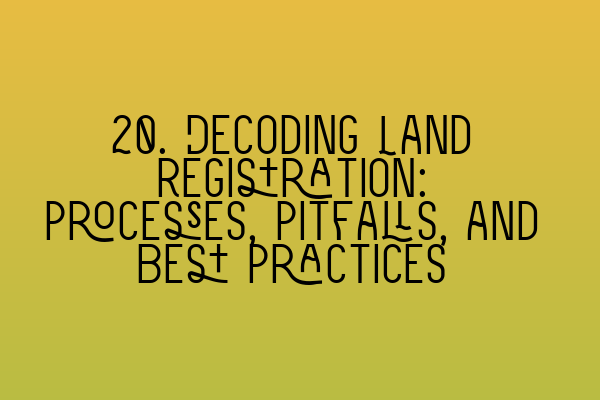Decoding Land Registration: Processes, Pitfalls, and Best Practices
Welcome to SQE Property Law & Land Law! As solicitors specializing in property and land law, we understand the intricacies of land registration and the importance of navigating this process carefully. In this blog post, we will decode the land registration process, highlight common pitfalls, and provide best practices to ensure a smooth and successful registration.
Understanding Land Registration
Land registration is the process of officially recording the ownership, rights, and interests in land and property. It provides a legal framework for the transfer and protection of land rights, ensuring security and certainty for property owners.
Under the Land Registration Act 2002, land registration is compulsory for most transactions involving registered land. The registration process involves submitting an application to the Land Registry, which examines the application and creates an official record of ownership.
There are two main types of land registration: first registration and registration of title. First registration occurs when land is registered for the first time, while registration of title involves updating an existing registered title with new information or changes.
The Land Registration Process
The land registration process can be complex, involving multiple steps and requirements. Here is a simplified overview of the process:
- Prepare the application: Before submitting an application, thorough preparation is essential. This includes gathering all necessary documents, such as deeds, plans, and official forms.
- Complete the forms: The application forms provided by the Land Registry must be completed accurately and in compliance with their guidelines. Any errors or omissions can result in delays or rejection of the application.
- Submit the application: Once the forms are completed, they must be submitted to the Land Registry along with the required fee. The application is then processed by the Land Registry.
- Examination and verification: The Land Registry examines the application and verifies the information provided. This may involve additional queries or requests for further documentation.
- Official decision: After examination, the Land Registry makes an official decision regarding the registration. This decision can result in registration, rejection, or requisitions for additional information or corrections.
- Completion of registration: If the application is approved, the Land Registry updates the register and issues an official certificate of registration. The registration is complete, and the new registered title is legally recognized.
Common Pitfalls and Challenges
While the land registration process is designed to ensure accuracy and certainty, there are common pitfalls that may arise. Understanding these challenges can help you avoid potential delays and complications:
- Incomplete or inaccurate information: Providing incorrect or incomplete information in the application forms can lead to rejection or requisitions for additional information. It is crucial to double-check all details and ensure accuracy.
- Missing documents: Failure to include all necessary documents can result in delays. Make sure to gather all required documents, including deeds, plans, and official forms, before submitting the application.
- Complex ownership structures: Properties with complex ownership structures, such as joint ownership or trust arrangements, may require additional documentation or clarification. Seek legal advice to ensure compliance with the Land Registry requirements.
- Boundary disputes: Disputes over property boundaries can complicate the registration process. It is important to resolve any boundary-related issues before submitting the application.
- Incorrect fees: Paying the incorrect fee can result in delays or rejection of the application. Check the current fee schedule provided by the Land Registry to ensure accurate payment.
Best Practices for Successful Land Registration
To maximize the chances of a successful land registration, follow these best practices:
- Thoroughly review and complete application forms: Carefully review all application forms, ensuring accurate and complete information. Double-check for any errors or omissions before submitting the forms.
- Seek legal advice: Property transactions can be complex, and seeking legal advice is recommended. A solicitor specialized in property and land law can guide you through the process, ensuring compliance with all requirements.
- Organize and gather all necessary documents: Create a checklist of all required documents and gather them before submitting the application. This minimizes the risk of missing or incomplete documentation.
- Resolve any disputes or outstanding issues: Address any boundary disputes or outstanding issues related to the property before initiating the registration process. Resolving these issues beforehand can prevent delays and complications.
- Double-check payment: Verify the correct fee for the application and ensure accurate payment. This avoids unnecessary delays or rejection due to incorrect fees.
By following these best practices and understanding the land registration process, you can navigate the complexities of land registration with confidence and minimize the risk of delays or complications.
We hope this blog post has provided valuable insights into land registration, common pitfalls, and best practices. If you need further assistance or legal advice, please don’t hesitate to contact us. Our team of experienced property law solicitors is here to help you.
Related Articles:
